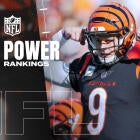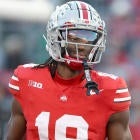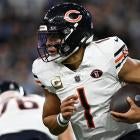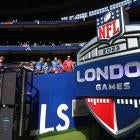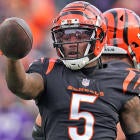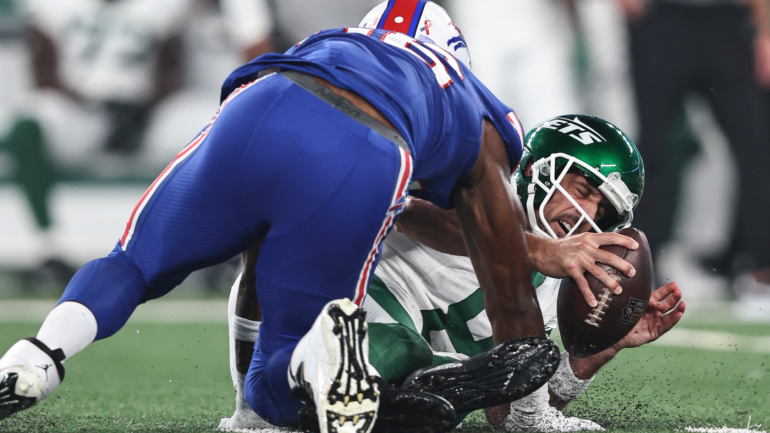
One pass. That's how many attempts Aaron Rodgers had during his first season as the New York Jets' quarterback. The four-time league MVP's season abruptly ended Monday night when he suffered a complete Achilles tear on the Jets' fourth offensive play. New York ultimately beat the Bills, 22-16, but they be without their starting quarterback for the final 16 games of the 2023 season.
Ironically, Rodgers isn't the first prominent quarterback in Jets history to tear his Achilles in the season-opener. Fresh off an AFC Championship Game appearance the following season, the Jets lost Vinny Testaverde to an Achilles injury in Week 1 of the 1999 season. The Jets ultimately managed to go 8-8 that season in what was Bill Parcells' final year as New York's head coach.
While the 2023 Jets' story is still being written, it's safe to already include Rodgers' injury among the most impactful ones over the past 60 years. Here's a look at the other impactful injuries Rodgers is now associated with.
Y.A. Tittle (1964)
A year after winning league MVP and taking the Giants to the NFL title game, Tittle's Hall of Fame career essentially ended in a daze in Pittsburgh. He sustained a concussion and cracked sternum while throwing a pick-six in a September game against the Steelers. The scene of a bloodied Tittle sitting on the Pitt Stadium grass after getting injured is one of the most iconic images in NFL history.
Tittle ended up playing the rest of the season, but the then 37-year-old was never the same player he was before the injury. The future Hall of Famer retired at season's end.
OTD 1964: Pittsburgh Post-Gazette photographer Morris Berman's iconic shot of Giants QB Y.A. Tittle, bloodied and battered at the hands of the #Steelers defense, Pitt Stadium. pic.twitter.com/kXmmsUE9Ow
— Kevin Gallagher (@KevG163) September 20, 2018
Gale Sayers (1968)
A week after rushing for a career-high 205 yards, the Bears' All-Pro halfback suffered a devastating knee injury in a November game against the 49ers. Sayers won Comeback Player of the Year honors in 1969 but was never the same player he was before the injury. He retired after playing in a combined four games during his final two seasons in Chicago.
Despite his short career (he played in just 68 games), Sayers was inducted into the Pro Football Hall of Fame in 1977 while becoming the youngest-ever Hall of Fame inductee at age 34. Prior to the injury, Sayers won two rushing titles and still holds the record for most total touchdowns in a single game (six).
40 | Gale Sayers pic.twitter.com/C3MsEsxDYx
— Jim McMahon (@JimMcMahon) September 27, 2022
Darryl Stingley (1978)
The former Patriots receiver suffered a life-altering injury after against the Raiders during the preseason. Stingley, who had just negotiated a contract with the Patriots that would have made him one of the NFL's highest-paid receivers, broke his fourth and fifth cervical vertebrae and spent the rest of his life as a quadriplegic. The injury and the attention it created inspired the NFL to change several rules regarding hits to the head.
At the time, however, Tatum's hit was considered legal and it did not result in a penalty or fine. Stingley's death in 2007 was attributed to heart disease and pneumonia that was complicated by quadriplegia.
Joe Theismann (1985)
A Super Bowl-winning QB and league MVP just several year earlier, Theismann's career came to an abrupt end after he suffered a compound fracture of the tibia and fibula in his right leg after being sacked by Lawrence Taylor on "Monday Night Football." The graphic images resulting from the injury shocked the millions of fans who watched it in real time.
The injury led to a heightened importance on left tackles charged with protecting the quarterback's blind side. Washington missed the playoffs that year but would win Super Bowls in 1987 and 1991 with different quarterbacks.
Joe Montana (1990)
The 49ers were on the precipice of possibly becoming the first team to win three straight Super Bowls prior to Montana getting hurt in the 1990 NFC Championship Game. Montana left the game after getting drilled from behind by Giants defensive lineman Leonard Marshall. The 49ers, who were in the lead with Montana under center, ultimately lost the game on a last-second field goal. New York ended up upsetting the Bills a week later in Super Bowl XXV. Montana ultimately suffered a bruised sternum, bruised stomach, cracked ribs and a broken hand.
Flashback Friday: Leonard Marshall recounts the famous hit on Joe Montana
— New York Giants (@Giants) December 2, 2022
Watch: https://t.co/9gKxsIbCw4 pic.twitter.com/JCbMK7YrBV
Montana's injury woes didn't end there. An elbow injury sustained in the following preseason resulted in him missing the next two seasons. With Montana sidelined, Steve Young ascended into an MVP-caliber player, which led to the 49ers trading Montana to Kansas City in 1993. Montana enjoyed a successful two-year run with the Chiefs before retiring. Young led the 49ers to their fifth and most recent Super Bowl win at the end of the 1994 season.
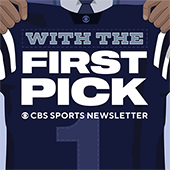
With The First Pick Newsletter
With The First Pick Newsletter
Prepare for the upcoming NFL Draft with the day’s big stories + mock drafts, big board updates and more.
Thanks for signing up!
Keep an eye on your inbox.
Sorry!
There was an error processing your subscription.
Bo Jackson (1990)
One of the pro sport's biggest stars as the time, Jackson had recently become the first professional athlete to become an All-Star in two sports: football and baseball. Jackson's career, however, was forever altered when he dislocated his hip during the Raiders' divisional round playoff win over the Bengals. Jackson never played football again and was on the sideline for the entirety of the Raiders' 51-3 loss to Buffalo in the AFC Championship Game.
"It was the difference," Amy Trask, a former Raiders CEO and longtime member of the team's front office, recently said of Jackson's absence against Buffalo. "You can never control for a variable, but could you imagine that difference in the game the next week if Bo is good to go? It's just a different game."
Jackson never returned to the NFL, but in 1993 he did become the first American professional athlete to compete with an artificial hip as a member of the MLB's Chicago White Sox.
4/9/93 - White Sox LF Bo Jackson blasts a 2-run homer off Yankees reliever Neal Heaton. It was Bo’s first home run after missing the previous season recovering from hip surgery. #MLB #baseball #sports #hip #Chicago #WhiteSox #chitown #Illinois #NFLDraft2020 #bo #raiders #vegas pic.twitter.com/g0ZRUZhZ9B
— Classic MLB vids (@classicMLBvids) April 24, 2020
Phil Simms (1990)
The MVP of Super Bowl XXI, Simms appeared to be on his way to leading the Giants to another Super Bowl win four years later. The Giants would eventually win the Super Bowl, but did so with backup Jeff Hostetler under center after Simms broke his foot after leading the Giants to an 11-2 start. Ironically, the injury occurred against the Bills, the team Hostetler and Co. would upset in Super Bowl XXV.
Simms' spent most of the 1991 season as Hostetler's backup before he was re-named as the Giants' starter before the start of the '92 season. He and the Giants enjoyed a resurgent season that included a Pro Bowl nod for Simms and a divisional round playoff appearance for New York. Simms' career ended the following summer after he underwent surgery to repair a torn labrum.
Randall Cunningham (1991)
The former Eagles' star was coming off of four straight Pro Bowl selections entering the 1991 season. Cunningham's season ended early when he suffered a torn ACL in Philadelphia's season-opening win over the Packers. The Eagles missed the playoffs without Cunningham despite posting a 10-6 record. Washington, Philadelphia's divisional rival, ended up winning both the NFC East and Super Bowl with Cunningham sidelined.
Cunningham returned the following season and led the Eagles to the franchise's first playoff win in a dozen years. While he was never quite the same player as he was before his injury, Cunningham played at an All-Pro level in 1998 while helping the Vikings go 15-1 during the regular season. He enjoyed a successful partnership that year with then-rookie Randy Moss, who caught an NFL rookie record 17 touchdowns.
Dan Marino (1993)
The Dolphins were a popular Super Bowl pick going into the '93 season after making to within a game of the Super Bowl the previous January. Miami started 4-1 but lost its future Hall of Fame quarterback when Marino tore his Achilles in a win over the Browns. The Dolphins still managed to get to 9-2 without Marino but missed the playoffs after dropping each of their final five games. The Bills, who defeated the Dolphins in the previous year's AFC title game, went onto represent the AFC in the Super Bowl for a fourth straight year.
Marino returned from the injury with gusto; he threw for 473 yards and five touchdowns in leading Miami to a win over the Patriots to start the '94 season. Marino ultimately won Comeback Player of the Year honors after throwing 30 touchdowns and leading the Dolphins to the playoffs. The Dolphins came up short in the playoffs, however, when the Chargers overcame a 21-6 deficit to shock Miami in the divisional round.
September 4th, 1994:
— King of Phinland🐬👑 (@KingOfPhinland) April 13, 2023
Dan Marino in his first game back from his Achilles injury led the Dolphins to a season opening win vs the Patriots in a 39-35 shootout. Marino threw for 473yds and 5TDs and Irving Fryar finished the game with 211yds and 3TDs. Legendary performance🔥 pic.twitter.com/A0WxN63ZXH
Rod Woodson (1995)
The NFL's Defensive Player of the Year two years earlier, Woodson suffered a torn ACL in Week 1 as he was trying to tackle Lions running back Barry Sanders. With Woodson sidelined, the Steelers started 3-4 but finished with an 11-5 record. A big reason for the turnaround was Carnell Lake's successful transition from safety to cornerback with Woodson out.
After the Steelers advanced to Super Bowl XXX, Woodson (who successfully convinced Steelers coach Bill Cowher to keep his spot on the 53-man roster open) made history by playing in that game and becoming the first American professional athlete to return to play in the same season after suffering a major knee injury. Woodson played well in the Steelers' 27-17 loss to the Cowboys.
Woodson's injury, however, was likely part of the reason why the Steelers parted ways with him after the 1996 season. The Steelers thought that Woodson had lost a step after giving up several long touchdowns in '96. Woodson was far from finished, however. He played seven more years after leaving Pittsburgh and won a Super Bowl as the Ravens' starting free safety in 2000.
Jerry Rice (1997)
Despite turning 35 that season, Rice signed a lucrative four-year extension with the 49ers prior to the '97 season. Rice barely played that year, however, after tearing his ACL and MCL in a Week 1 loss to Tampa Bay. Rice willed himself back onto the field for the 49ers' Monday night showdown with the Broncos in Week 16. He caught a touchdown pass in that game but would miss the rest of the season after cracking his patella after scoring the touchdown.
With Rice injured, then second-year wideout Terrell Owens received a bigger workload and helped the 49ers reach the NFC title game. Owens ultimately supplanted Rice as the 49ers' No. 1 receiver the following season.
Terrell Davis (1998)
Davis was arguably the league's best player from 1997-98, when he won league and Super Bowl MVP honors while setting several NFL records over that span. His career took an unfortunate turn, however, in Week 4 of the 1999 season when he tore his ACL and MCL while trying to make a tackle after an interception. Davis missed the rest of the season, and the two-time defending champion Broncos finished 6-10.
Davis returned in 2000 but retired before the start of the 2002 season, as he was no longer the player he was prior to the injury. Like Sayers, Davis was inducted into the Hall of Fame despite having an abbreviated career cut short by injuries. He still holds the record for the most touchdown runs in a single postseason (eight during the 1997 playoffs) and is one of eight running backs to rush for more than 2,000 yards in a season.
Drew Bledsoe (2001)
The face of the Patriots, Bledsoe was also the league's highest-paid player after receiving a record-setting contract ahead of the 2001 season. But Bledsoe's time as the Patriots' star quarterback abruptly ended when he was crushed by Jets linebacker Mo Lewis near the end of New England's Week 2 loss to New York. Initially thought to be a concussion, it was discovered at the hospital that Bledsoe suffered a sheared blood vessel in his chest which caused a hemothorax, which is when blood collects between the chest and the lung.
While Bledsoe recovered, backup quarterback Tom Brady ascended an helped the Patriots split their first 10 games. It was then that Bill Belichick named Brady his permanent starter despite Bledsoe being cleared to return to the field.
In a twist of fate, Bledsoe was called upon later that season when Brady was injured early on in the AFC Championship Game. Bledsoe, who hadn't played since Week 2, came in and threw a pivotal touchdown pass that helped New England defeat the Steelers, 24-17. Bledsoe was back on the bench, however, when Brady led a game-winning drive a week later in Super Bowl XXXVI.
Bledsoe was traded to Buffalo that offseason, where he was named to his fourth and final Pro Bowl in 2002. A member of the Patriots Hall of Fame, Bledsoe set an NFL record for pass attempts (70) and completions (45) in an NFL game. He is also just one of three quarterbacks to start for the Patriots in a Super Bowl.
In 2001, Tom Brady replaced Drew Bledsoe, who was the youngest No. 1 overall pick QB to start a Super Bowl (24), and had signed an NFL-record 10-year, $103M deal that offseason. pic.twitter.com/z7xXStBYH6
— ESPN Stats & Info (@ESPNStatsInfo) November 16, 2021
Michael Vick (2003)
One of the biggest victims of the "Madden" cover curse, Vick missed all but four games in 2003 after he fractured his right fibula against Baltimore in a preseason game. The injury came a year after Vick earned his first Pro Bowl nod while leading the Falcons to an upset win over the Packers in the wild-card round.
Fully healthy in 2004, Vick earned the first of back-to-back Pro Bowl nods while leading Atlanta to within a game of the Super Bowl. His injury in 2003 contributed to star players playing less in the preseason in subsequent years.
Carson Palmer (2005)
The most gut-wrenching moment in Bengals' history did not occur during their three Super Bowl losses. It instead took place during the opening sequence of their team's 2005 wild-card playoff game against the Steelers. Carson Palmer, who had torched Pittsburgh's defense in a win over the Steelers a month earlier, left the game after sustaining a career-threatening knee injury after completing a 66-yard pass to Chris Henry on the Bengals' second play from scrimmage.
Cincinnati still managed to take a 17-7 lead but were unable to stay with the Steelers, who eventually became the first six seed to win the Super Bowl. That offseason, the NFL's Competition Committee modified the rule regarding low hits on quarterbacks.
Tom Brady (2008)
On a play that forever changed how quarterbacks are protected, Brady's 2008 season was wiped out after he suffered ACL and MCL tears to his knee as the result of a low hit by Chiefs safety Bernard Pollard. While the Patriots managed to go 11-5 without Brady, they missed the playoffs a year after nearly pulling off the first 18-0 season in NFL history.
Matt Cassel, who filled in for Brady that season, was a Pro Bowler for the Chiefs in 2010 but went just 36-45 as a starting quarterback.
Peyton Manning (2011)
Neck and spinal surgeries (which came after the Colts signed him to a five-year, $90 million deal) ultimately sidelined Manning for the entire 2011 season. The Colts then made the difficult decision to release Manning, who signed with the Broncos the following offseason. Manning, a multiple league and Super Bowl XLI MVP with the Colts, won two more league MVPs in Denver while becoming the first starting quarterback to win Super Bowls with multiple franchises.
The Colts (who went 2-14 in Manning's absence in 2011), used the No. 1 overall pick in the 2012 to select Andrew Luck, who led the Colts to an upset win over Manning's Broncos in the 2014 playoffs. Luck shockingly retired in 2019, however, after enduring multiple injuries during his short career.
Ryan Shazier (2017)
The former Steelers' linebacker was among the front-runners to win Defensive Player of the Year entering Pittsburgh's Week 13 Monday night matchup in Cincinnati. Shazier's career took an unfortunate turn that night, however, when he suffered a serious injury that required him to undergo spine stabilization surgery.
Shazier never played again, but he has enjoyed a successful recovery. The 2017 Steelers, however, never recovered from Shazier's injury. Pittsburgh lost its shot at the No. 1 seed with a late-season loss to New England and was then upset by the Jaguars in the divisional round of the playoffs. Shazier's presence in those games could have made the difference.
Alex Smith (2018)
A three-time Pro Bowler with the Chiefs, Smith's first season in Washington ended with a severe leg injury against the Texans that nearly led to an amputation. Washington finished the season with a 7-9 record after entering its game against Houston with a 6-3 record.
Remarkably, the injury did not end Smith's career, as he returned to the field in 2020 following two years of grueling rehab. He won Comeback Player of the Year in 2020 after helping Washington capture a division title.
Tua Tagovailoa (2022)
The Dolphins' quarterback had a scary moment when he suffered a concussion during Miami's Week 4 loss to the Bengals in Week 4. The Dolphins came under scrutiny after the game for playing Tagovailoa after he had appeared to have suffered a head injury during the team's win over Buffalo the previous week.
Tagovailoa would miss Miami's next two games and would miss the season's final two games after suffering another head injury agains the Packers on Christmas Day. Tagovailoa spent the offseason recovering and adding muscle in an attempt to better protect himself from big hits.
Damar Hamlin (2022)
Hamlin endured a life-threatening incident in Cincinnati on prime time during the 2022 season. Hamlin went into cardiac arrest after getting hit during the first quarter of Buffalo's Week 17 matchup with the Bengals. Hamlin had CPR performed on him on the field before he was transported to a nearby hospital, where he was released a week later.
Hamlin has made a full recovery and successfully made the Bills' 53-man roster entering the 2023 regular season. Hamlin, who received an outpouring of support during his hospitalization, is using the donations he received during that time to fund his foundation.
Instead of continuing the game, the NFL ultimately canceled the Bengals-Bills game. The Chiefs ultimately won the No. 1 seed, while the Bengals had to settle for the AFC's No. 3 seed. Cincinnati defeated the Bills in Buffalo in the divisional round but lost a 23-20 decision in Kansas City in an AFC title game rematch.















